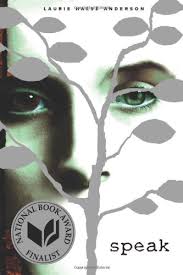Crutcher, c. (2018). Staying fat for Sarah Byrnes. S.l.: Greenwillow books.
Eric Calhoun and Sarah Byrnes are longtime friends. They understand each other and have a strong connection. Eric is overweight, and referred to as "Moby" by his peers, and Sarah is disfigured after a childhood accident which left face and hands burned. They are outcasts and are glad to have each other.
Throughout the story, Eric reminisces about their underground newspaper, "Crispy Pork Rinds,” and the subject of a lot of their stories, a bully Dale Thornton, who unknown to Eric shares a secret with Sarah about her childhood. As they transition into their high school years, Eric begins to shed his weight while competing on the swim team and making lots of friends. He struggles to maintain his heavyset body, as a type of loyalty to his friend Sarah so she doesn’t feel alone. One day, Sarah becomes catatonic and ends up in a mental ward, leaving Eric feeling sad and a deep desire to help his dearest friend. Dale finally shares Sarah’s secret of her abusive father, Virgil Byrnes, and the source of her scars. He realizes that Sarah’s catatonia may not be genuine, but more of a ruse to keep her in a hospital and safe from harm at the hands of her father.
Soon, with the help and advice of his swim coach Ms. Lemry, they devise a plan to help Sarah escape the ward and hide from her father in Ms. Lemry's apartment attic. While Sarah and Ms. Lemry try searching for her mother for help, Eric is confronted and stabbed by Sarah's father in his search for her. The story comes to an intense climax as Dale once again steps in to help his friend, "Moby,” and Sarah's father gets what’s coming to him. He eventually is found guilty and sentenced to 20 years in prison, and Sarah gets a second chance at a happy life.
Crutcher does a good job keeping the story suspenseful as the events play out, especially the scene where Virgil is chasing Eric. The reader can tell that Virgil mistreats Sarah, but the depth of his depravity is slowly revealed throughout the story. The characters are well-developed and are relateable to a lot of young adult readers. Most teenagers have felt unhappy with themselves to some degree. Both Eric and Sarah are funny, smart, and caring. Their friendship is unbreakable, and their loyalty to each other is inspiring.The ending did leave a bit to be desired because it felt rushed. There were some loose ends left unanswered and Sarah’s adoption seemed like an afterthought.
I also felt like Crutcher’s voice was evident in the book through some of the content. It came across as a bit opinionated. It’s ironic to me when someone is pushy for tolerance, but meanwhile is not tolerant of other’s beliefs. The themes present in this book are both strong and somewhat controversial. It includes child abuse, abortion, and religious intolerance. It wasn’t my favorite book, but I think the contemporary issues are suitable for readers in the high school range of YA Lit. Readers will be able to relate to the characters and some of their experiences.
**Required YA author
Other books by Chris Crutcher:
Deadline ISBN 978-0060850913
The Sledding Hill ISBN 978-0060850913
Interview with Chris Crutcher about inspiration for Sarah Byrnes





